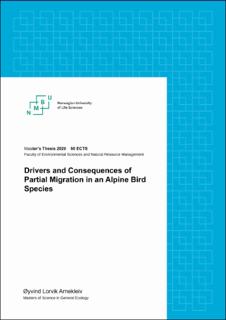| dc.description.abstract | 1. Partial migration, where parts of a population migrate between winter and summer (breeding) areas and the rest remain year-round resident, is a common phenomenon across several bird species. However, both drivers and consequences of the decision to migrate in partially migrating bird populations are poorly understood.
2. Several hypotheses have been put forward to explain why some individuals migrate whereas others stay resident, as well as the fitness consequence of a given strategy.
3. In this thesis, I used data from n=73 radio-tagged female willow ptarmigan Lagopus lagopus in an alpine study area in Central Norway to test key hypothesis about drivers and consequences of partial migration. Specifically, I tested i) to which extent the decision to migrate was dependent on individual state variables such as age and body-size, ii) if individuals repeat migratory behaviour between seasons, and iii) if the consequences of migratory strategy affect fitness in terms of nesting performance.
4. I found that juvenile birds with small body-sizes were more likely to migrate whereas large juveniles stayed resident. However, body-size did not explain migratory strategy in adult females. There was strong evidence for high individual repeatability of migratory strategy between seasons. However, migratory strategy did not explain variation in nesting performance between individuals.
5. These results suggest partial migration in willow ptarmigans to be determined by body size as juveniles, which becomes a part of the individual life history as a fixed strategy. Fitness seems not to be affected by migratory strategy, but survival as fitness parameter should be accounted for. This study provides data which enhances our knowledge of migratory behaviour in female willow ptarmigans and should be taken into consideration in further advancements in managing this species. | en_US |

